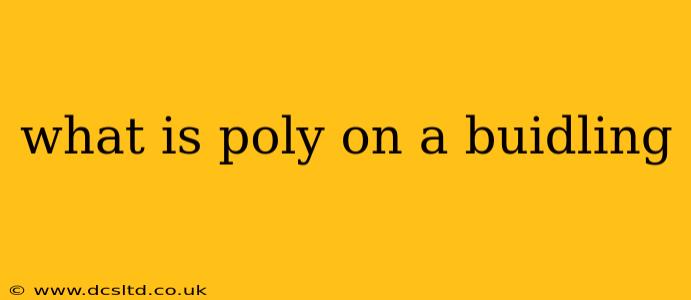"Poly" on a building typically refers to polyurethane foam insulation. This versatile material is increasingly popular in construction due to its exceptional thermal performance, versatility, and ease of application. Let's delve deeper into what poly (polyurethane foam) is and its various applications in building construction.
What is Polyurethane Foam Insulation?
Polyurethane foam insulation is a synthetic material created by combining two chemical components: a polyol and an isocyanate. When these are mixed, a chemical reaction occurs, expanding the mixture into a rigid foam. This foam is characterized by its cellular structure, containing countless tiny air pockets that trap heat and prevent its transfer. This makes it an incredibly effective insulator.
There are two primary types of spray polyurethane foam (SPF):
-
Open-cell spray foam: This type has a more porous structure, allowing for some air permeability. It's lighter and less expensive than closed-cell foam but offers slightly lower R-value (insulating capacity) per inch.
-
Closed-cell spray foam: This type has a denser structure with smaller, completely sealed cells. It's more expensive but offers superior R-value, better air sealing, and superior moisture resistance.
Why is Polyurethane Foam Used in Building Construction?
Polyurethane foam offers a multitude of advantages for building projects:
-
Exceptional Thermal Performance: Its high R-value significantly reduces energy loss through walls, roofs, and floors, leading to lower energy bills and a smaller carbon footprint.
-
Superior Air Sealing: Polyurethane foam creates an airtight seal, preventing drafts, reducing air infiltration, and improving indoor air quality. This is crucial for energy efficiency and preventing moisture problems.
-
Versatile Application: It can be sprayed into various spaces and cavities, making it ideal for irregular shapes and hard-to-reach areas.
-
Moisture Resistance: Closed-cell polyurethane foam provides excellent resistance to moisture penetration, protecting the building envelope from water damage.
-
Structural Strength: In some cases, polyurethane foam can contribute to the structural integrity of the building, particularly when used as a composite material.
-
Sound Dampening: Polyurethane foam has sound-dampening properties, reducing noise transfer between rooms and from outside sources.
What are the Different Applications of Polyurethane Foam in Buildings?
Polyurethane foam insulation finds applications in various parts of a building:
-
Walls: Both exterior and interior walls can benefit from polyurethane foam insulation, improving energy efficiency and comfort.
-
Roofs: Spray foam insulation is particularly effective for roofs, preventing heat loss in the winter and heat gain in the summer.
-
Attics: Insulating attics with polyurethane foam minimizes heat transfer and reduces energy consumption.
-
Foundations: Polyurethane foam can be used to insulate crawl spaces and basements, preventing moisture problems and improving energy efficiency.
-
Commercial Buildings: Large-scale projects like warehouses, industrial buildings, and commercial structures utilize spray polyurethane foam for its speed of application and cost-effectiveness.
What are the Environmental Considerations of Using Polyurethane Foam?
While polyurethane foam offers significant advantages, it's crucial to consider its environmental impact. Some formulations contain blowing agents with high global warming potential. However, the industry is moving towards more environmentally friendly options with lower global warming potential blowing agents. It's essential to choose products with appropriate certifications and low environmental impact.
Is Polyurethane Foam Expensive?
The cost of polyurethane foam insulation varies depending on the type (open-cell vs. closed-cell), the thickness required, and the area being insulated. While generally more expensive than traditional insulation materials like fiberglass, its superior performance often results in long-term cost savings through reduced energy bills.
What are the potential drawbacks of polyurethane foam insulation?
While largely beneficial, polyurethane foam insulation has potential drawbacks:
- Cost: As mentioned, it can be more expensive upfront compared to other insulation methods.
- Professional Installation: It usually requires specialized equipment and professional installers, increasing the overall cost.
- Off-gassing: Some formulations can release volatile organic compounds (VOCs) during and after installation. Choosing low-VOC options is important.
- Flammability: While treated to be fire-retardant, it's still flammable and requires appropriate fire safety precautions.
By understanding the various aspects of polyurethane foam insulation – its properties, applications, and considerations – you can make informed decisions about its use in your building projects. Remember to consult with qualified professionals for proper installation and selection of suitable products.
